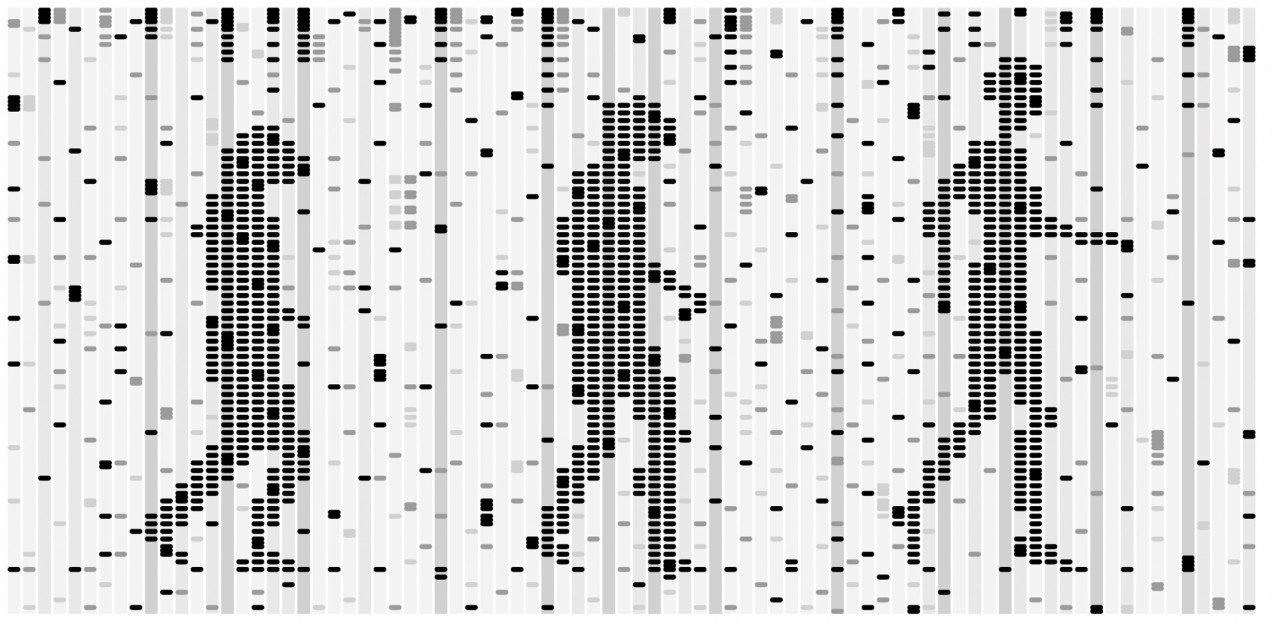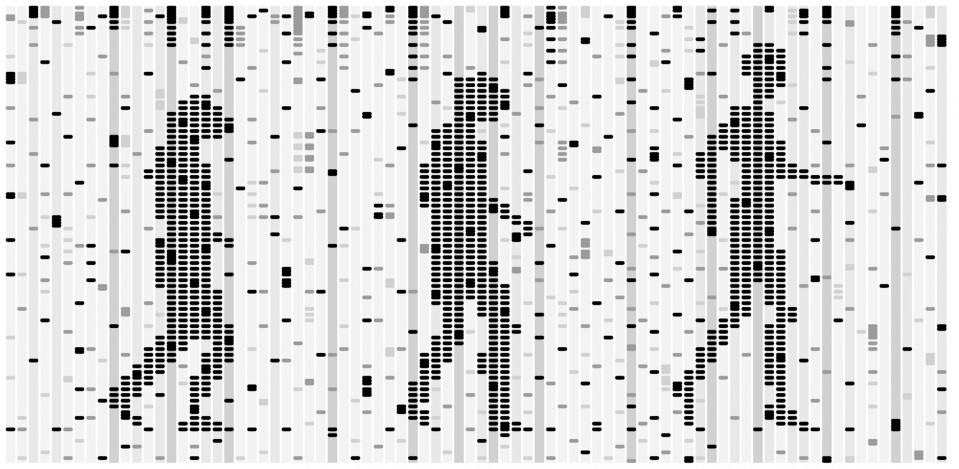

Rewriting Life
The History Inside Us
Improvements in DNA analysis are helping us rewrite the past and better grasp what it means to be human.

Every day our DNA breaks a little. Special enzymes keep our genome intact while we’re alive, but after death, once the oxygen runs out, there is no more repair. Chemical damage accumulates, and decomposition brings its own kind of collapse: membranes dissolve, enzymes leak, and bacteria multiply. How long until DNA disappears altogether? Since the delicate molecule was discovered, most scientists had assumed that the DNA of the dead was rapidly and irretrievably lost. When Svante Pääbo, now the director of the Max Planck Institute for Evolutionary Anthropology in Germany, first considered the question more than three decades ago, he dared to wonder if it might last beyond a few days or weeks. But Pääbo and other scientists have now shown that if only a few of the trillions of cells in a body escape destruction, a genome may survive for tens of thousands of years.
In his first book, Neanderthal Man: In Search of Lost Genomes, Pääbo logs the genesis of one of the most groundbreaking scientific projects in the history of the human race: sequencing the genome of a Neanderthal, a human-like creature who lived until about 40,000 years ago. Pääbo’s tale is part hero’s journey and part guidebook to shattering scientific paradigms. He began dreaming about the ancients on a childhood trip to Egypt from his native Sweden. When he grew up, he attended medical school and studied molecular biology, but the romance of the past never faded. As a young researcher, he tried to mummify a calf liver in a lab oven and then extract DNA from it. Most of Pääbo’s advisors saw ancient DNA as a “quaint hobby,” but he persisted through years of disappointing results, patiently awaiting technological innovation that would make the work fruitful. All the while, Pääbo became adept at recruiting researchers, luring funding, generating publicity, and finding ancient bones.
Eventually, his determination paid off: in 1996, he led the effort to sequence part of the Neanderthal mitochondrial genome. (Mitochondria, which serve as cells’ energy packs, appear to be remnants of an ancient single-celled organism, and they have their own DNA, which children inherit from their mothers. This DNA is simpler to read than the full human genome.) Finally, in 2010, Pääbo and his colleagues published the full Neanderthal genome.
That may have been one of the greatest feats of modern biology, yet it is also part of a much bigger story about the extraordinary utility of DNA. For a long time, we have seen the genome as a tool for predicting the future. Do we have the mutation for Huntington’s? Are we predisposed to diabetes? But it may have even more to tell us about the past: about distant events and about the network of lives, loves, and decisions that connects them.
Empires
Long before research on ancient DNA took off, Luigi Luca Cavalli-Sforza made the first attempt to rebuild the history of the world by comparing the distribution of traits in different living populations. He started with blood types; much later, his popular 2001 book Genes, Peoples, and Languages explored demographic history via languages and genes. Big historical arcs can also be inferred from the DNA of living people, such as the fact that all non-Africans descend from a small band of humans that left Africa 60,000 years ago. The current distribution across Eurasia of a certain Y chromosome—which fathers pass to their sons—rather neatly traces the outline of the Mongolian Empire, leading researchers to propose that it comes from Genghis Khan, who pillaged and raped his way across the continent in the 13th century.
But in the last few years, geneticists have found ways to explore not just big events but also the dynamics of populations through time. A 2014 study used the DNA of ancient farmers and hunter-gatherers from Europe to investigate an old question: Did farming sweep across Europe and become adopted by the resident hunter-gatherers, or did farmers sweep across the continent and replace the hunter-gatherers? The researchers sampled ancient individuals who were identified as either farmers or hunters, depending on how they were buried and what goods were buried with them. A significant difference between the DNA of the two groups was found, suggesting that even though there may have been some flow of hunter-gatherer DNA into the farmers’ gene pool, for the most part the farmers replaced the hunter-gatherers.
Looking at more recent history, Peter Ralph and Graham Coop compared small segments of the genome across Europe and found that any two modern Europeans who lived in neighboring populations, such as Belgium and Germany, shared between two and 12 ancestors over the previous 1,500 years. They identified tantalizing variations as well. Most of the common ancestors of Italians seem to have lived around 2,500 years ago, dating to the time of the Roman Republic, which preceded the Roman Empire. Though modern Italians share ancestors within the last 2,500 years, they share far fewer of them than other Europeans share with their own countrymen. In fact, Italians from different regions of Italy today have about the same number of ancestors in common with one another as they have with people from other countries. The genome reflects the fact that until the 19th century Italy was a group of small states, not the larger country we know today.
Significant events in British history suggest that the genetics of Wales and some remote parts of Scotland should be different from genetics in the rest of Britain, and indeed, a standard population analysis on British people separates these groups out. But this year scientists led by Peter Donnelly at Oxford uncovered a more fine-grained relationship between genetics and history. By tracking subtle patterns across the genomes of modern Britons whose ancestors lived in particular rural areas, they found at least 17 distinct clusters that probably reflect different groups in the historic population of Britain. This work could help explain what happened during the Dark Ages, when no written records were made—for example, how much ancient British DNA was swamped by the invading Saxons of the fifth century.
The distribution of certain genes in modern populations tells us about cultural events and choices, too: after some groups decided to drink the milk of other mammals, they evolved the ability to tolerate lactose. The descendants of groups that didn’t make this choice don’t tolerate lactose well even today.
Mysteries
Analyzing the DNA of the living is much easier than analyzing ancient DNA, which is always vulnerable to contamination. The first analyses of Neanderthal mitochondrial DNA were performed in an isolated lab that was irradiated with UV light each night to destroy DNA carried in on dust. Researchers wore face shields, sterile gloves, and other gear, and if they entered another lab, Pääbo would not allow them back that day. Still, controlling contamination only took Pääbo’s team to the starting line. The real revolution in analysis of ancient DNA came in the late 1990s, with second-generation DNA sequencing techniques. Pääbo replaced Sanger sequencing, invented in the 1970s, with a technique called pyrosequencing, which meant that instead of sequencing 96 fragments of ancient DNA at a time, he could sequence hundreds of thousands.
Such breakthroughs made it possible to answer one of the longest-running questions about Neanderthals: did they mate with humans? There was scant evidence that they had, and Pääbo himself believed such a union was unlikely because he had found no trace of Neanderthal genetics in human mitochondrial DNA. He suspected that humans and Neanderthals were biologically incompatible. But now that the full Neanderthal genome has been sequenced, we can see that 1 to 3 percent of the genome of non-Africans living today contains variations, known as alleles, that apparently originated with Neanderthals. That indicates that humans and Neanderthals mated and had children, and that those children’s children eventually led to many of us. The fact that sub-Saharan Africans do not carry the same Neanderthal DNA suggests that Neanderthal-human hybrids were born just as humans were expanding out of Africa 60,000 years ago and before they colonized the rest of the world. In addition, the way Neanderthal alleles are distributed in the human genome tells us about the forces that shaped lives long ago, perhaps helping the earliest non-Africans adapt to colder, darker regions. Some parts of the genome with a high frequency of Neanderthal variants affect hair and skin color, and the variants probably made the first Eurasians lighter-skinned than their African ancestors.
Ancient DNA will almost certainly complicate other hypotheses, like the African-origin story, with its single migratory human band. Ancient DNA also reveals phenomena that we have no other way of knowing about. When Pääbo and colleagues extracted DNA from a few tiny bones and a couple of teeth found in a cave in the Altai Mountains in Siberia, they discovered an entirely new sister group, the Denisovans. Indigenous Australians, Melanesians, and some groups in Asia may have up to 5 percent Denisovan DNA, in addition to their Neanderthal DNA.
In a very short amount of time, a number of ancients have been sequenced by teams all over the world, and the growing library of their genomes has facilitated a new kind of population genetics. What is it that DNA won’t be able to tell us about the past? It may all come down to what happened in the first moments or days after someone’s death. If, for some reason, cells dry out quickly—if you die in a desert or a dry cave, if you are frozen or mummified—post-mortem damage to DNA can be halted, but it may never be possible to sequence DNA from remains found in wet, tropical climates. Still, even working with only the scattered remains that we have found so far, we keep gaining insights into ancient history. One of the remaining mysteries, Pääbo observes, is why modern humans, unlike their archaic cousins, spread all over the globe and dramatically reshaped the environment. What made us different? The answer, he believes, lies waiting in the ancient genomes we have already sequenced.
There is some irony in the fact that Pääbo’s answer will have to wait until we get more skillful at reading our own genome. We are at the very beginning stages of understanding how the human genome works, and it is only once we know ourselves better that we will be able to see what we had in common with Neanderthals and what is truly different.
Christine Kenneally is the author of The Invisible History of the Human Race, to be published in October.
Advertisement